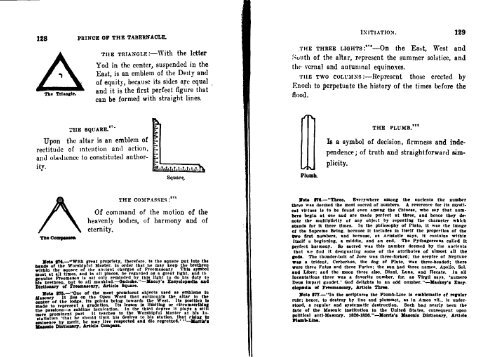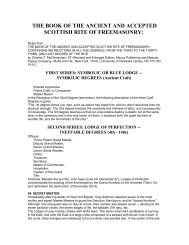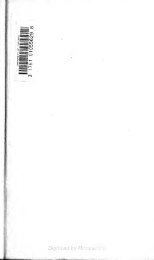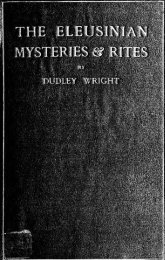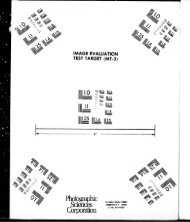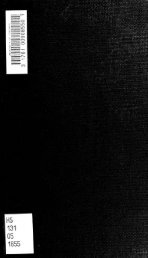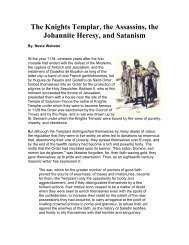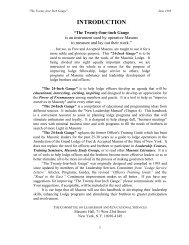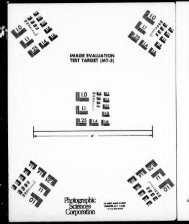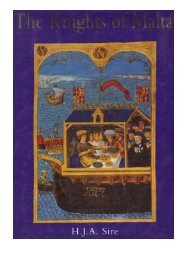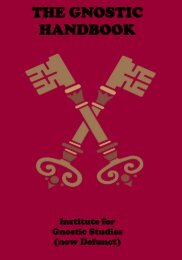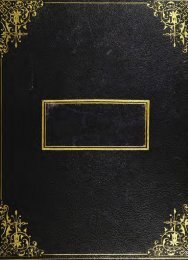Scottish Rite Masonry Illustrated - The Masonic Trowel
Scottish Rite Masonry Illustrated - The Masonic Trowel
Scottish Rite Masonry Illustrated - The Masonic Trowel
Create successful ePaper yourself
Turn your PDF publications into a flip-book with our unique Google optimized e-Paper software.
128 PRINCE OP THE TAnERNACLL<br />
UE SQUARE.<br />
TIlE TRIANGLE :—With the letter<br />
Yod in the center, suspended in the<br />
East, is an emblem of the DeIty and<br />
of equity, because its sides are equal<br />
and it is the first perfect figure that<br />
can be formed with straight lines.<br />
5,—<br />
Upon the altar is an emblem of<br />
rectitude of intention anti action,<br />
and obedIence to constituted authority.<br />
<strong>The</strong> CouIaaafi.<br />
.st’<br />
THE COMPASSES.<br />
Squarq.<br />
Of command of the motion of the<br />
heavenly bodies, of harmony and of<br />
eternity.<br />
Note 374.——with great propriety, therefore. is the square put into the<br />
bands of the worshipf~il Master. In order that he may keep the brethren<br />
within the square of the ancient charges of Freemasonry This symbol<br />
must at all times. and in all places. be regarded as a great light, and ti~<br />
genuine Freemasun Is nut oniy reminded by this light to do his duty to<br />
his brethren, but to all mankind.—Gadicks.‘ ‘—Maeoys Encyclopudia and<br />
Dictionary of Freemasonry, Article Square.<br />
Mote 375.—”One of the most prominent objects used as emhlems In<br />
<strong>Masonry</strong> It lies on the Open word that surmotiata the altar in the<br />
center of the lodge. Its ~lute being towards the west. Its position Is<br />
made to represent a gradation. Its lesson is limiting or clrcumaerIhIng<br />
the passions—s sublime inculcation. In ihe third degree It ploys a still<br />
more prominent part It teaches to the worshipful Master at his Inatsliatlun<br />
flhst he should limit his desires to his station. ihst rising to<br />
eminence by merit, he may Wee respected and dIe regretted ‘—Mania’s<br />
Maaeaic Dictionary, Article Compass.<br />
INITIATIoN. 129<br />
TI-SE THREE LIGHTS:”—On the Eaht, West and<br />
~uutlI of the ahlar, represent the summer solstice, and<br />
tIt(’ vernal and autumnal equinoxes.<br />
TIlE TWO COLUMNS :—Represent those erected by<br />
Enoch to perpetuate the history of the times before the<br />
fitiod.<br />
~J<br />
THE<br />
phicity.<br />
Plumb.<br />
PLUMn.”’<br />
Is a symbol of decision, firmness and independence;<br />
of truth and straight forward s.im-<br />
Note IYS.—”Zhree. Everywhere among the ancients the number<br />
three was deemed the most sacred of numbers. A reverence for its mystical<br />
virtues is to he found even among the Chinese, who say that numhers<br />
begin at one and are made perfect at three, and hence they denote<br />
the multiplicIty of any object by repeating the character which<br />
stands for it three times. In the phIlosophy of Plato. it was the Image<br />
ef Ihe Supreme Being, because It includes in Itself the properties of the<br />
Owo first numbers, and because, 55 Aristotle says, it contains within<br />
Itself a beginnIng, a middle, and an end. <strong>The</strong> Pythagoreana called It<br />
perfect harmony, So sacred was this number deemed by the ancients<br />
that we Sod it designating some of the attributes of almost all the<br />
gods. <strong>The</strong> thunder-bolt of Jove was three-forked; Ibe sceptre of Neptune<br />
was a Indent, Cerberbus. the dog of Pluto. was three-headed; there<br />
were three Fates and three Furies; the sun had three names. Apollo. Sol,<br />
and Liber: and the moon three also, Ditini. Luna, and Hecate. In all<br />
Incantations Ibree was a favorite number, for, as virgil says, ‘numero<br />
Deus impari gsudet.~ God delights in an odd number. ‘—Mackey’s Eney.<br />
olopadia of Freemasonry, Article Three,<br />
Note 37v—’In the scriptures the Plumb-Line is emblematic of regular<br />
rule; hence, to destroy by line and plummet, as In Amos vIl., Is understood,<br />
a regular and systematic desiruction. Such had nearly been the<br />
fate of the <strong>Masonic</strong> institution in the UnIted States, consequent upon<br />
political antI-<strong>Masonry</strong>. 1526-1536. —MolTise <strong>Masonic</strong> Dictionary, Article<br />
Plumb-Line.


